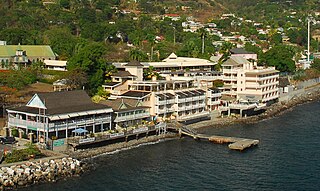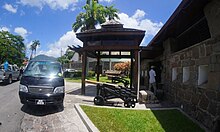The first written records in the history of Dominica began in November 1493, when Christopher Columbus spotted the island. Prior to European contact, Dominica was inhabited by the Arawak. Dominica was a French colony from 1715 until the end of the Seven Years' War in 1763, and then became a British colony from 1763 to 1978. It became an independent nation in 1978.

Saint Lucia was inhabited by the Arawak and Kalinago Caribs before European contact in the early 16th century. It was colonized by the British and French in the 17th century and was the subject of several possession changes until 1814, when it was ceded to the British by France for the final time. In 1958, St. Lucia joined the short-lived semi-autonomous West Indies Federation. Saint Lucia was an associated state of the United Kingdom from 1967 to 1979 and then gained full independence on February 22, 1979.

Roseau is the capital and largest city of Dominica, with a population of 14,725 as of 2011. It is a small and compact urban settlement, in the Saint George parish and surrounded by the Caribbean Sea, the Roseau River and Morne Bruce. Built on the site of the ancient Island Carib village of Sairi, it is the oldest and most important urban settlement on the island of Dominica.

The Dominica Story: A History of the Island is a history book from 1975, written by Dominican historian Lennox Honychurch. It was the first published history of the island. Originally presented as a miniseries for Radio Dominica in 1974, the inaugural edition covered every aspect of local history from prehistory up to the then-present.

Île aux Noix is an island on the Richelieu River in Quebec, close to Lake Champlain. The island is the site of Fort Lennox National Historic Site of Canada. Politically, it is part of Saint-Paul-de-l'Île-aux-Noix.
Lennox Honychurch is a Dominican historian and politician. He wrote 1975's The Dominica Story: A History of the Island, the 1980s textbook series The Caribbean People, and the 1991 travel book Dominica: Isle of Adventure. Also an artist and a curator, he was largely responsible for compiling the exhibit information for The Dominica Museum in Roseau. Honychurch is the grandson of writer and politician Elma Napier.

Cabrits National Park is on a peninsula at the north end of the Caribbean island of Dominica, north of Portsmouth. The park protects tropical forest, coral reefs and wetlands. There are hiking trails and an English garrison called Fort Shirley.

Wesley is a village in Saint Andrew Parish in north-eastern Dominica. It situated between the old estates of Eden and Londonderry and 1 1/2 miles southeast of Woodford Hill. Like many other villages along the east coast, Wesley developed after Emancipation on hilly land along the boundary between the two estates as labourers sought to establish independent holdings for themselves away from the plantations where they had formerly lived and worked.

Scotts Head is a village on the southwest coast of Dominica, in Saint Mark Parish. In 2001, its population was 721. Predominantly a fishing village, Scotts Head overlooks Soufrière Bay, which is protected as the Soufrière Scotts Head Marine Reserve. It is also a popular snorkeling and diving site for tourists.

Marigot is the largest settlement of Saint Andrew Parish in northeastern Dominica. The village has a population of 2,676 people, and is home to a Fisheries Complex as well as the island's main airport.

The Kalinago Territory, previously known as the Carib Reserve or Carib Territory (outdated/derogatory), is a 3,700-acre (15 km2) district in the Caribbean island country of Dominica. It was established for the Indigenous Kalinago people who inhabited the region prior to European colonization and settlement.

The Invasion of Dominica was a successful French invasion of the island of Dominica in the British West Indies, during the American Revolutionary War. The action took place before British authorities in the Caribbean were aware that France had entered the war as an ally of the United States of America. The French governor in the West Indies, François Claude Amour, marquis de Bouillé, was notified on 17 August that France was at war, and organized the invasion, infiltrating spies to rally sympathetic French-speaking Dominican support.

The Chief of the Kalinago Territory presides over the Kalinago Council, the local government of the Kalinago Territory. The position is the equivalent of a village council chairperson elsewhere in Dominica. Beginning in the late 20th century, Kalinago Chiefs have also acted as a representative of the Kalinago Territory to other indigenous populations in the Caribbean region, and have worked with organizations including the Caribbean Organization of Indigenous Peoples and the United Nations Working Group on Indigenous Populations.

Agostino Brunias was an Italian painter who was primarily active in the West Indies. Born in Rome around 1730, Brunias spent his early career as a painter after graduating from the Accademia di San Luca. After he befriended prominent Scottish architect Robert Adam and accompanied him back to Britain, Brunias left for the British West Indies to continue his career in painting under the tutelage of Sir William Young. Although he was primarily commissioned to paint the various planter families and their plantations in the West Indies, he also painted several scenes featuring free people of colour and cultural life in the West Indies. Brunias spent most of his West Indian career on the island of Dominica, where he would die in 1796. Historians have made disparate assessments of Brunias's works; some praised his subversive depiction of West Indian culture, while others claimed it romanticised the harshness of plantation life. Haitian revolutionary Toussaint Louverture was a prominent admirer of his work.

Fort Young Hotel is a hotel on the quayside of Roseau, Dominica, in the southern part of the capital next to Garraway Hotel, Dominica Museum, the Roseau Public Library, just south of the Governor's Residence and Roseau Cathedral. Located within the ramparts of the old colonial military Fort Young of 1770s vintage and built in the backdrop of a quay overlooking the Caribbean Sea, the 71-room hotel was established in 1964 and hosts a diving centre.

Sir William Young, 1st Baronet was an Antiguan-born politician and planter. He served as President of the Commission for the Sale of Lands in the Ceded Islands, and was appointed the first non-military governor of Dominica in 1768.
Campbell Dalrymple was a British military officer who was Governor of Guadeloupe during the British occupation of that island during the Seven Years' War. After Guadeloupe was returned to the French under the Treaty of Paris, he argued strongly for making Dominica a free trade area so as to capture the French Caribbean trade.
Dominican nationality law is regulated by the 1978 Constitution of the Commonwealth of Dominica, as amended; the Citizenship Act, and its revisions; and various British Nationality laws. These laws determine who is, or is eligible to be, a national of Dominica. Dominican nationality is typically obtained either on the principle of jus soli, i.e. by birth in Dominica; or under the rules of jus sanguinis, i.e. by birth abroad to parents with Dominican nationality. It can also be granted to persons with an affiliation to the country, or to a permanent resident who has lived in the country for a given period of time through naturalisation. There is also, currently a program in Dominica for acquiring nationality by investment. Nationality establishes one's international identity as a member of a sovereign nation. Though it is not synonymous with citizenship, for rights granted under domestic law for domestic purposes, the United Kingdom, and thus the commonwealth, have traditionally used the words interchangeably.

Fort Shirley is a historic military outpost on the Caribbean island of Dominica. It was built by the British in 1765, and was named for Sir Thomas Shirley. The fort was the location of the 1802 revolt of the 8th West India Regiment. Today, Fort Shirley is part of Cabrits National Park, which was established as a national park in 1986.

Fort Cachacrou was a historic military fortification and signal station on the island of Dominica. The fort was built by the British in the 1760s in present-day Scotts Head. During the American Revolutionary War, it was the site of the first battle in the French Invasion of Dominica. Remains of Fort Cachacrou include portions of the original walls and a canon. The site is accessible via the Waitukubuli National Trail.





















